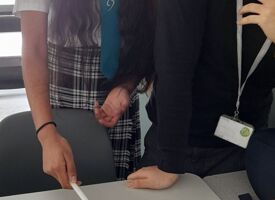KS4 Science - Homemade Electroscope
Posted on: 04/04/2022Last Monday, our wonderful KS4 physicists investigated how well different materials produce static electricity by making a homemade electroscope and testing it out. Static electricity is the build-up of electrical charge in an object. Sometimes static electricity can suddenly discharge, like when a bolt of lightning flashes through the sky. Other times, static electricity can cause objects to cling to each other, like socks fresh out of the dryer.
To build their electroscope, our KS4 physicists made two holes near the bottom of a polystyrene cup and pushed a plastic straw through both holes in the cup. They then attached an aluminium ball to a string and taped the string to the tip of the straw. Next, they rubbed one of the materials using a piece of cloth before placing it near the electroscope and measuring the distance moved by the aluminium ball. The larger the distance, the more static electricity it produces.
At the end of the session, students had the opportunity to investigate static electricity further using an electrostatic generator: the Van de Graaf. Our brave Y10 student Asagi electrostatically charged herself using the Van de Graaf before grounding herself on the Bunsen. The resulting spark was enough to ignite the gas!
A huge thank you to our Y12 scientists: Anuyah, Roberto, Yasmin, Mania and Elona for their help

